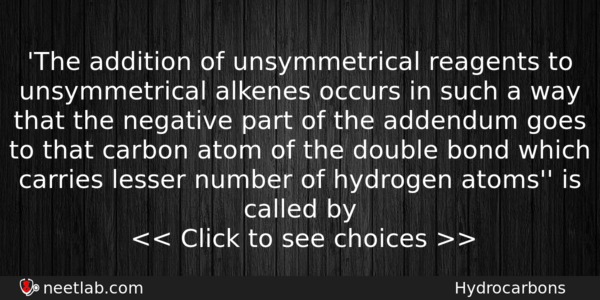| ⇦ | 
| ⇨ |
‘The addition of unsymmetrical reagents to unsymmetrical alkenes occurs in such a way that the negative part of the addendum goes to that carbon atom of the double bond which carries lesser number of hydrogen atoms” is called by
Options
(a) Saytzeff rule
(b) Markownikoff’s rule
(c) Kharasch effect
(d) Anti-Saytzeff rule
Correct Answer:
Markownikoff’s rule
Explanation:
No explanation available. Be the first to write the explanation for this question by commenting below.
Related Questions: - The number of sigma and pi-bonds in but-1-ene-3-yne are
- Borax is used as a cleansing agent because on dissolving in water it gives
- Standard reduction potential for Al³⁺/Al , Fe²/Fe, Br/Br are ₋1.66V, ₋0.45V, 1.09V
- The molecular weight of a gas is 45. Its density at STP is
- Terfenadine is commonly used as a
Topics: Hydrocarbons
(84)
Subject: Chemistry
(2512)
Important MCQs Based on Medical Entrance Examinations To Improve Your NEET Score
- The number of sigma and pi-bonds in but-1-ene-3-yne are
- Borax is used as a cleansing agent because on dissolving in water it gives
- Standard reduction potential for Al³⁺/Al , Fe²/Fe, Br/Br are ₋1.66V, ₋0.45V, 1.09V
- The molecular weight of a gas is 45. Its density at STP is
- Terfenadine is commonly used as a
Topics: Hydrocarbons (84)
Subject: Chemistry (2512)
Important MCQs Based on Medical Entrance Examinations To Improve Your NEET Score
18000+ students are using NEETLab to improve their score. What about you?
Solve Previous Year MCQs, Mock Tests, Topicwise Practice Tests, Identify Weak Topics, Formula Flash cards and much more is available in NEETLab Android App to improve your NEET score.
Share this page with your friends

Leave a Reply